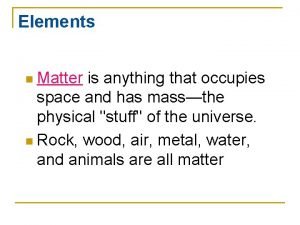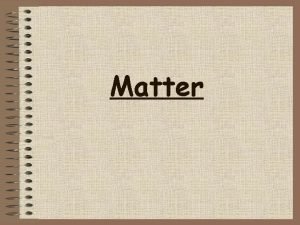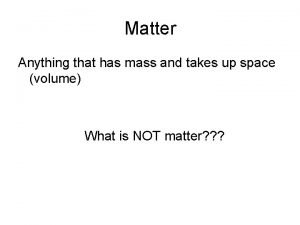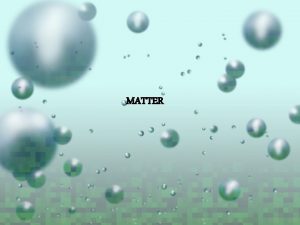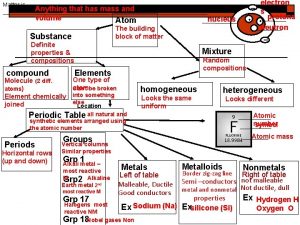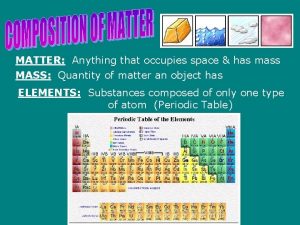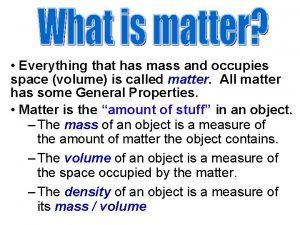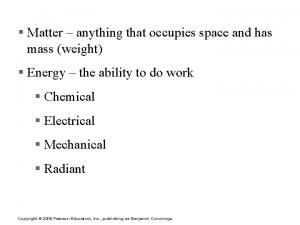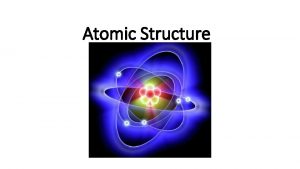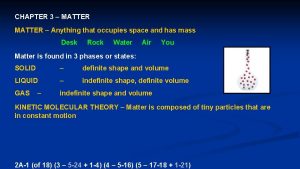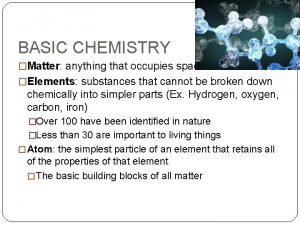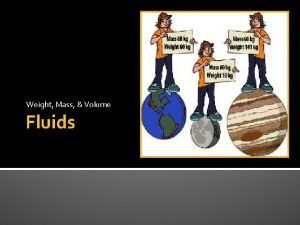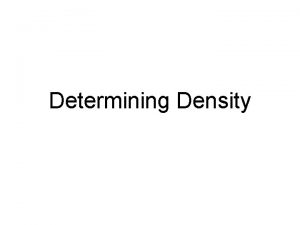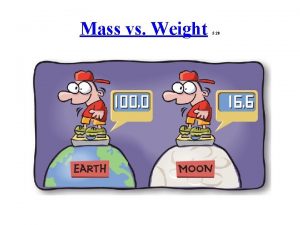Anything that has occupies mass space Mass Weight

















- Slides: 17

Anything that has occupies mass & space

Mass Weight • Stays Constant • Changes with location • Measures quantity of matter • Measures the pull of gravity (which changes) on an object • Unit is kilogram (kg) or gram (g) • Unit is Newton (N)

Classification All matter can be classified into two groups ØSubstances ØMixtures

¤ Elements – Cannot be broken down into other substances by ordinary chemical change – 112 elements – Many atoms of one type=Element ¤ Compounds – Elements in compound are combined in definite proportions • Always the SAME proportion for any given compound – The compound has new properties different from the elements that make it up.

Elements ±Have the SAME properties as any other pure sample of the same element ±Symbols H, O, As Compounds § Have the SAME properties as any other pure sample of the compound § Formulas: H 2 O, KCl, CO 2

• • H 2 O C 12 H 22 O 11 C H Co As CO 2

Consist of 2 or more substances that retain their individual properties

• Homogenous – The mixture has the same composition throughout. – Ex: Coffee is mixed thoroughly so that it is the same strength everywhere • Heterogeneous – The mixture has a different composition throughout. It is unevenly mixed. – Ex. : Trail mix – you can pick out the raisins if you don’t want them.

• Only one set of properties • Composition always fixed – ex: H 2 O or Cl 2 • Always HOMOGENEOUS • Each constituent keeps it own properties – ex: sugar mixed in H 20 • Composition varies e. g. very sweet or a little sweet • May be Homogeneous or Heterogeneous

• Element + other element • Compound + other compounds • Element + Compound

Classification Scheme MATTER Mixtures Substances Heterogeneous or Homogenous Element + Compound + Compound Element Compound

Element-Compound-Mixture? • H 2 SO 4 • Steel girders – Steel = alloy • As (Arsenic) – Alloy is a solid • Aqueous (watersolution of 2 or more based) Na. Cl solution metals • Sand + H 2 O • C 2 H 5 OH • Zinc washers (pure Zn)

Chemical Formulas How to interpret them and what they mean!

Two Special Cases of Elements: Monatomic vs. Diatomic • Monatomic: – Each molecule consists of a single atom. – Element examples: • Ne, Ar, Xe, Kr, Rn • Metals: Mg, Zn, Fe, Co, Na • Diatomic: – Each molecule consists of two atoms. – Element examples: • H 2, N 2, Cl 2

Diatomic Elements • These elements have diatomic molecules – RECORD AND MEMORIZE!!!: – – – – Hydrogen -- H 2 Oxygen -- O 2 Nitrogen -- N 2 Chlorine -- Cl 2 Fluorine -- F 2 Bromine -- Br 2 Iodine -- I 2

How to interpret Chemical Formulas • What does H 2 O mean? – There are H (hydrogen) and O (oxygen) in this compound. – The small 2 (2) after the H means there are two hydrogens. – The O with no number (you do NOT write 1) means there is one oxygen.

Some Examples: H 2 SO 4 S 8 CH 4 Na. Cl NH 4 Br KNO 3 Mg. Cl 2 Cu. Fe. S 2 C 6 H 6 NH 3 Zn. Cl 2 Fe
 It is anything that has mass and occupies space
It is anything that has mass and occupies space Matter has mass and occupies space
Matter has mass and occupies space The matter is anything that occupies
The matter is anything that occupies Matter is anything that:
Matter is anything that: Matter is anything that:
Matter is anything that: Matter is anything that has mass and
Matter is anything that has mass and Matter is anything that has
Matter is anything that has Matter is anything that has and takes up
Matter is anything that has and takes up Matter is anything that has
Matter is anything that has Matter is anything that has
Matter is anything that has Anything that has mass and volume
Anything that has mass and volume Everything that has mass and volume
Everything that has mass and volume Anything that takes up space and has mass
Anything that takes up space and has mass Anything defintion
Anything defintion Anything that has matter and takes up space
Anything that has matter and takes up space Matter is anything that has mass and volume
Matter is anything that has mass and volume Phân độ lown
Phân độ lown Block nhĩ thất độ 2 type 1
Block nhĩ thất độ 2 type 1




